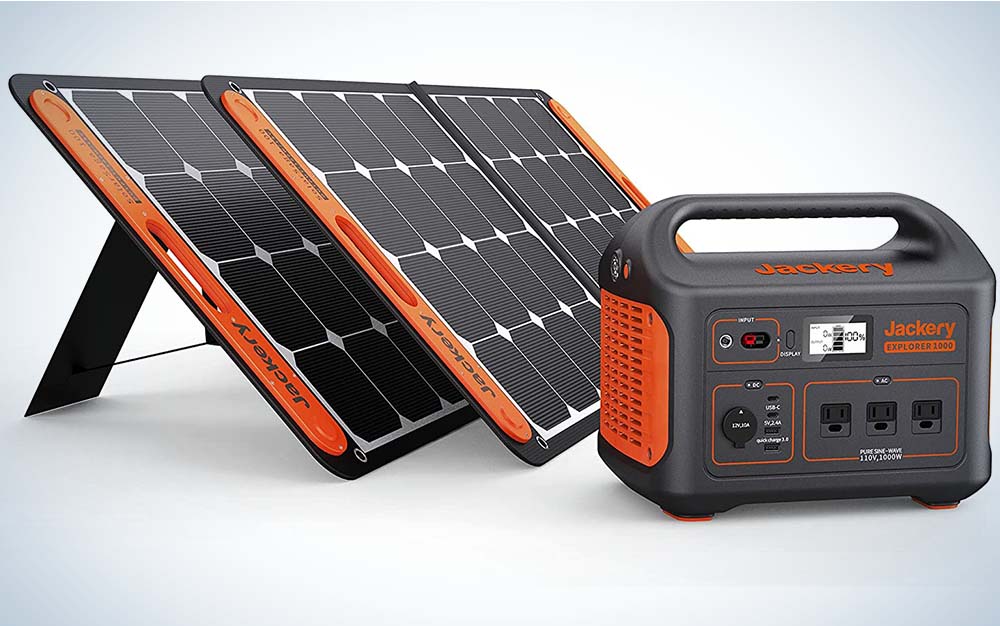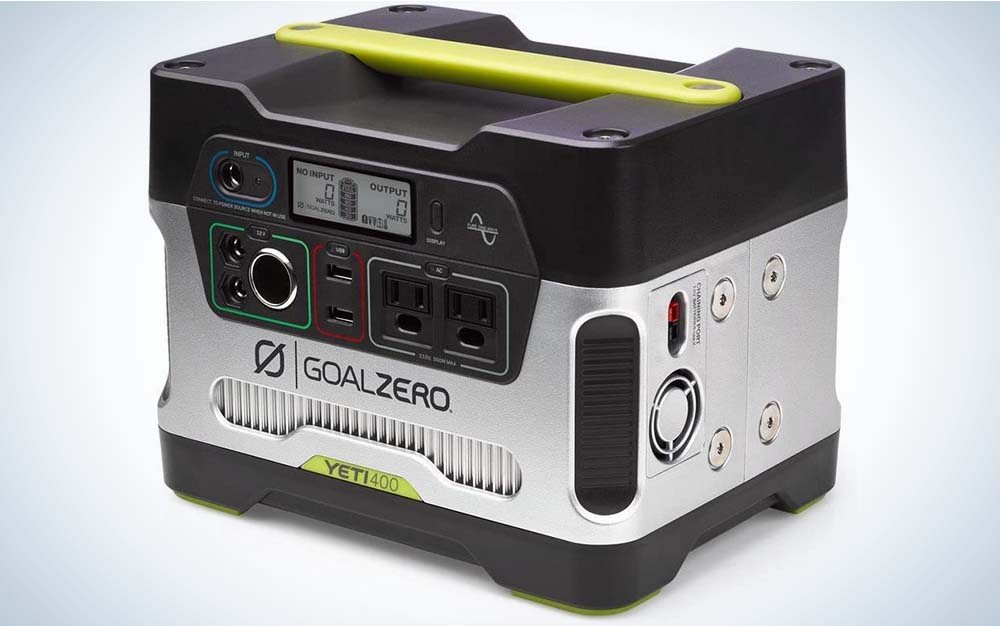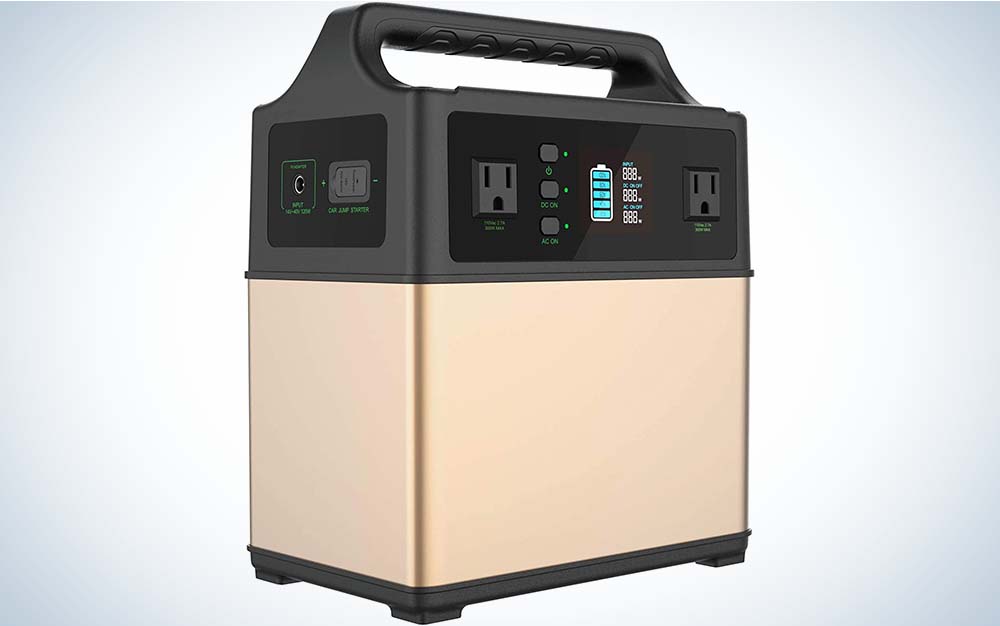Titan, Bluletti, Jackery, EcoFlow, Goal Zero
We may earn revenue from the products available on this page and participate in affiliate programs.
|
Best Overall
|

|
Jackery 1000
|
Check Price
|
LEARN MORE
|
Summary
A versatile generator that’s best suited for low-power needs.
|
|
Best Budget for Home
|

|
Goal Zero Yeti 400
|
Check Price
|
LEARN MORE
|
Summary
A quality, easy-to-use generator that won’t break the bank.
|
|
Best for Camping
|

|
MAXOAK 400W Portable Power Station
|
Check Price
|
LEARN MORE
|
Summary
Lightweight and equipped for roadside emergencies—perfect for camping.
|
It’s hot in the summer months; the sun can cook you as red as a lobster if you don’t take the proper precautions. But love it, like it, or hate it, the sun is one of the best sources of renewable, containable, clean energy at our disposal. And thanks to advances in solar panels, capturing and reserving power (especially if you’re off the grid) is simple, practical, and efficient. But not all generators are created equal. To help you find the best solar generators for you, I’ve tested a collection of the top models based on their charging and run times as well as their features.
- Best Overall: Jackery 1000
- Best Heavy-Duty: Titan Solar Generator
- Best Generator Kit: Patriot 1800
- Most Efficient: BLUETTI AC200MAX
- Best Budget for Home: Goal Zero Yeti 400
- Best Recharge Time: EcoFlow DELTA
- Best for Camping: MAXOAK 400W Portable Power Station
Solar Power: The Gift that Keeps on Giving
Unlike gas-powered generators that emit harmful fumes, solar-powered generators gather fuel from that big fireball in the sky via solar panels. This makes standby solar generators a great option for not only camping or tailgating, but also as short-term energy alternatives when a storm knocks out the power for a few hours.
That said, the inner workings of the best solar generators are somewhat more complicated than their gas-powered counterparts, which means many models are sometimes burdened with a higher price tag. To help you find the best unit for your needs, here are a few other good, bad, and ugly things you should know about solar-powered generators before you buy one. Check out this list of the best solar generators, their helpful features, and a shortlist of considerations to mull over so you don’t burn through your green trying to go green.
Best Overall: Jackery 1000
Key Features
- 1,000Wh capacity
- Two 100W solar panels
- 3 AC and 5 DC ports
Why It Made the Cut
Given its dimensions, weight, and recharge time, this device can power almost anything—even high-wattage appliances—in a pinch. But it’s best suited for low-power needs when you’re off the grid or need something charged or powered for a short window of time.
Pros
- Lightweight (22 pounds)
- Variety of output ports
- Quiet
Cons
- Emits some noise
- Long recharge time
- Panels aren’t weather resistant
Product Description
Contrary to the old saying about taking anything with you beyond the grave, when it comes to solar-powered generators, you want to take it with you, wherever you go. That’s what makes the Jackery 1000 somewhat of a “jack” of all trades. Compared to most units, it’s lightweight (22 pounds), extremely quiet, and loaded with possibly every output port you’ll ever need (AC, USM, 12V, 5V, USB-C, and Quick Charge 3.0). Though the recharge time takes a while, this unit’s two Solarsaga panels can run small devices and appliances for hours on a full charge.
Best Heavy-Duty: Titan Solar Generator
Key Features
- 3,000W continuous power output
- RV plug port
- Long battery life
Why It Made the Cut
While the Titan weighs over 60 pounds with just one battery (35 pounds each), it becomes nearly immovable if you add more. That said, it retains enough energy to power something as large as a refrigerator for several hours, making it a great option for home-emergency use.
Pros
- Expandable battery capacity
- Numerous input and output ports
- Simultaneously charge with AC and DC outlets
Cons:
Product Description
If there’s one misconception about solar-powered generators, it’s that people assume they’re lightweight, which makes sense. There’s no gas tank or oversized lawn mower engine to weigh it down. But in order to store the energy it gathers, solar generators need a reservoir, which is just a $20 term for a battery, and batteries are typically anything but lightweight.
But the larger the battery(s) often means higher output (watts) and a longer run time. The Titan Solar Generator has both, thanks to its stackable lithium-ion batteries. It’s large and heavy enough that you won’t want to constantly relocate it, but if your home needs a short-term power solution, the Titan could be your hero.
Best Generator Kit: Patriot 1800
Key Features
- 1,800W continuous power output
- High-quality steel housing
- Weight: 40 pounds
Why It Made the Cut
While it doesn’t have as many power ports as some of its gas-free competitors, the Patriot 1800 offers a lot of power and portability for the price.
Pros
- 100% emission-free
- Rechargeable for 2,500+ life cycles
- 12-month battery shelf life
Cons
- Long charge time
- No 220V hookup
- Slightly heavy
Product Description
There’s something to be said for all-in-one outfits. Like a packable first-aid kit—it might not include top-shelf components you prefer if you’re piecing your own kit together, but they’re certainly more than ample in a pinch. The same could be said for solar generators—it’s nice to have all you need, organized in one package for JIC moments. The Patriot 1800 won’t power your household appliances, but it comes with everything you need in an emergency or survival situation—solar cells, multiple power cords, personal water heater, solar lantern, tactical flashlight, and a 72-hour survival food kit. And since it weighs 40 pounds, it’s lightweight enough that you can load it in the back of your vehicle for a road trip or wherever you’re going.
Most Efficient: BLUETTI AC200MAX
Key Features
- 2,000W continuous power output
- 17 different outlets
- Bluetooth compatible
Why It Made the Cut
The BLUETTI AC200MAX works as good as it looks. The interface is easy to navigate, and since it has Bluetooth capabilities, you can connect it to your smartphone and receive updates from afar.
Pros
- Fast recharge time
- Rechargeable for 3,500+ life cycles
- Expandable battery capacity
Cons
- Heavy: 60+ pounds
- Large footprint
- Inadequate owner’s manual
Product Description
The worst part about recharging anything is the wait—especially if you forget to fully charge something before you need it. And if there’s something negative to be said about charging with solar panels, it’s that it can sometimes take longer than anticipated. With the BLUETTI AC200MAX, you can charge via solar and AC power simultaneously. That means it’s ready to run in less time than it takes most other solar-powered generators to reach half capacity. Need more power? No problem—you can attach additional batteries to this power station for more juice or longer run times. Doing so will certainly add to the overall weight of the station itself (60 pounds solo), but as long as you’re not migrating it from place to place (or you’re installing it somewhere permanent, like in a camp trailer), connecting a few extra cells is worth the peace of mind.
Best Budget for Home: Goal Zero Yeti 400
Key Features
- Weight: 29 pounds
- 396Wh capacity
- 300W continuous power output
Why It Made the Cut
The Goal Zero Yeti 400 offers quality performance at a price that won’t break the bank.
Pros
- Small footprint
- No noise, no fumes, and no maintenance
- Charges seven devices at one time
Cons
- Slightly heavy for its size
- Short battery lifespan
- Poor housing construction
Product Description
If you want power in a pinch but don’t want to break the bank for something you might use a few times a year (or less), the Goal Zero Yeti 400 is a great option. Its small footprint, zero emissions, and easy-to-use plug-and-play interface makes it an ideal asset for any home, garage, or workspace. It doesn’t offer the high output or capacity you’d find on more expensive models, but if you don’t plan to run or charge large appliances for extended periods of time, it’s ideal for less power-hungry devices.
Best Recharge Time: EcoFlow DELTA
Key Features
- 1260Wh capacity
- 1,800W continuous power output
- Weight: 30.9 pounds
Why It Made the Cut
The DELTA is relatively lightweight (30 pounds) and reaches a near full charge in less than 60 minutes.
Pros
- Detailed and easy-to-read LCD screen
- Fast recharge time
- High energy storage capacity
Cons
- Sometimes overheats
- Short battery lifespan
Product Description
As you shop for solar-powered generators, you’ll notice that a unit’s recharge time remains a constant concern. The faster you can refill a battery (or batteries), the sooner you’ll be able to hook up devices and begin draining them again. It’s one of the driving features behind EcoFlow’s DELTA series. The company claims that it’s able to charge 10X faster than other models and go from 0% to 80% charged within one hour if plugged into an AC outlet, or in as little as four hours using DELTA’s 160W solar panels. After fully charged, the DELTA can accommodate up to 13 devices at one time. And while the recharge time beats most other competitors, the battery life isn’t the greatest. But if you need a solar generator that can recharge in a hurry, the EcoFlow Delta is hard to beat.
Best for Camping: MAXOAK 400W Portable Power Station
Key Features
- Weight: 12.3 pounds
- 400Wh capacity
- 300W continuous power output
Why It Made the Cut
The lightweight MAXOAK 400W Portable Power Station makes it easy to carry for camping trips, and it even includes a pair of jumper cables if you forget to turn your headlights off.
Pros
- Lightweight and portable
- Equipped for roadside emergencies
- Ideal for camping or outdoor adventures
Cons
- Long recharge time
- Overheats in the sun
- Short battery lifespan
Product Description
Yes, most people escape to the outdoors to revisit the natural world and take a break from modern technology. But as much as we’d like to not admit it, there are times when you need to connect with a few volts and watts. That’s where the MAXOAK power station comes in handy. It’s lightweight (12 pounds) and small enough to stash inside your vehicle without taking up much space, and it’s great to have when your flashlight or camera needs new life. Just remember, a smaller unit typically means less power and capacity, so don’t be prepared for this to power up your entire camp for the weekend.
FAQs
Q: Are solar-powered generators worth the money?
Compared to gas-powered generators, solar-powered generators are slightly more expensive, but they’re worth the money. Solar generators are quieter, lighter, and rechargeable (no fuel costs), and since they don’t require servicing like oil or air filter changes, you can save on some costs over the long run. The key is making sure you select a unit that can hold and generate enough power to run whatever you plan to plug in for an extended amount of time.
Q: How do I choose a portable solar generator?
Before you choose a portable solar generator, determine how you’ll use it, the power output (watts) you’ll need to satisfy your electrical needs, and how long you plan to draw power from the unit. If you plan to transport it wherever you go, a smaller, lighter generator works best, but be prepared for low-power output since the batteries aren’t as large as high-output stationary models.
Also consider the batteries. Most generators have a watt-hour (Wh) rating, which refers to the battery and how much energy it can store fully charged. So, for example, if you have a 400Wh generator, it’s not able to power anything that requires more than 400-watts to run. Conversely, the more low-wattage devices to attach to a generator, the faster it depletes the battery. If you think you need more power, consider models with a high Wh rating or units designed to parallel several batteries in a row.
Q: Can a solar generator run a refrigerator?
watt-hour (Wh) rating is high enough to meet its demands. Generally, a high Wh rating of 1,500+ can support small appliances, freezers, and refrigerators but not for an extended period of time. If you think you’ll require a significant amount of electricity for an extended period of time, consider a model with 2,000Wh or more, but also be prepared to recharge it often if you want food or other provisions to remain chilled.
The Review Process
I tested models that ran the gamut from large to small capacity and from portable to “lift with your legs” weight. The key was testing the solar generators so that a heavyweight model wouldn’t outshine a light-use system. I measured their performance against each manufacturer’s specs rather than a head-to-head test.
I also evaluated charge time based on the manufacturer’s specified charge time. If the recharge times of a solar generator fell within the described range, it moved on to the next round.
The last consideration was pure power—which is different than run time because, ultimately, even the largest, highest-capacity solar generator won’t run forever. But while it is running, it’s good to know it will support whatever it’s designed to run, be it as something as power-hungry as a refrigerator or as insignificant as an LED light. After evaluating power, my best solar generator picks will handle their specified tasks.
How to Choose a Solar Generator
One trend you might see in this lineup is the importance of zeroing in on a solar generator that’s built for the task (or emergency) you have in mind. Anything more could be overkill, whereas anything less might be useless. Take the time to do a little math to figure out how much power (watts) you’ll need to pull from the generator and for how long. This is likely the most critical first step toward deciding which solar generator suits you best.
One thing worth noting—several solar generator manufacturers engineer their devices to achieve peak performance when paired with their brand’s accessories. That couldn’t be more evident than when it comes to solar panels. While there are several solar panel makes and models available, and connections between panels and generators are almost universal, you might not experience the same recharge rate with off-brand panels as you would with panels specifically designed for your unit. That said, unless you purchase an all-in-one kit, there will likely be an extra cost when you shop.
The same is true for batteries. If you’re considering a model with expandable capacities, know that batteries aren’t always inexpensive, and like anything else, they don’t last forever. Work within your budget to determine exactly just how much power you’re going to need for specific situations and let that dictate how many (or few) reserve cells you need to purchase.
Final Thoughts
The best solar generators certainly have specific advantages over fuel-powered machines, but quiet run times, no emissions, and virtually no maintenance requirements also come with a cost. Let’s face it, technology isn’t always cheap. However, if you appreciate that feeling of safety and protection knowing you have an alternative energy source that isn’t always running out of gas, then a portable solar generator is your best bet. Remember to evaluate your power needs, spending budget, and other features you might appreciate before you buy one.
The post Best Solar Generators for 2022 appeared first on Outdoor Life.
By: Ben Romans
Title: Best Solar Generators for 2022
Sourced From: www.outdoorlife.com/gear/best-solar-generators/
Published Date: Tue, 29 Mar 2022 16:55:00 +0000
----------------------------------------------
Did you miss our previous article...
https://manstuffnews.com/weekend-warriors/new-maryland-swordfish-crushes-previous-state-record-by-75-pounds
 Backyard GrillingWeekend WarriorsAdvice from DadBeard GroomingTV Shows for Guys4x4 Off-Road CarsMens FashionSports NewsAncient Archeology World NewsPrivacy PolicyTerms And Conditions
Backyard GrillingWeekend WarriorsAdvice from DadBeard GroomingTV Shows for Guys4x4 Off-Road CarsMens FashionSports NewsAncient Archeology World NewsPrivacy PolicyTerms And Conditions
